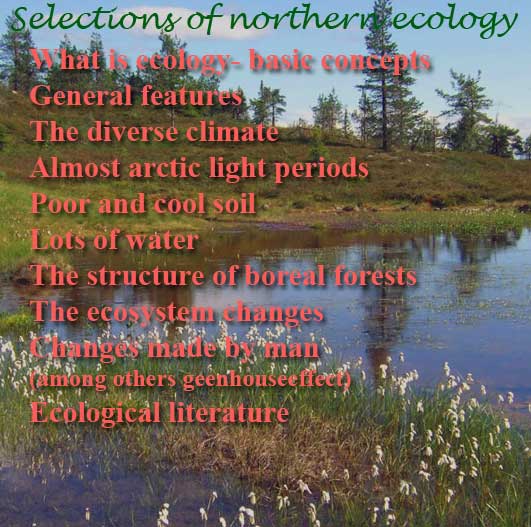
This is: 2. General features

Pick out one of the subjects of ecology on the up there!
See also:

![]()
1. General features of northern ecology

This is: 2. General features

Pick out one of the subjects of ecology on the up there!
See also:

![]()
1. General features of northern ecology
The general success of life (e.g. growth, reproduction, diversity) weakens towards the polar regions. Almost total limits of life are reached in the permanent glaciers of the polar regions.

Northern nature works mainly with the same principals as nature elsewhere. The source of energy is the sun in north, too, which is the prerequisite for green plants or producers to be able to live, grow and reproduce. The energy produced by plants is then utilised by consumers that are herbivores and predators. So the consumers - including man - are heterotrophic parasites. Anyhow the consumption of heterotrophic life is not very much here in the north - not to include man, reindeer and periodical mass occurrence of some smaller animals (for example some small mammals). There are in the northern areas - perhaps - about 5000 kg herbivores and 25000 kg primary producers and 1kg predrors. Because the primary production (= plant production) is slight in the north, is the amount of consumers slight, too. Phytomass of the coniferous forests in Southern Finland is some 300 to/ha/y, but close to the tundra-area in northernmost Fennoscandia 5 to/ha/y. More: producion of ecosystem! |
Nutrients and water circulate in the ecosystem. In the northern ecosystems there is usually no shortage of water, although the annual precipitation is low. However, water shortage (for plants desiccation) may be a problem in winter, when the water is mainly frozen. During the northern growth period, light is plentiful, but the rhythm and quality differ from southern ecosystems. On the other hand, low availability of nutrients, cool climate and great fluctuations in the weather conditions are typical minimisation factors in northern ecosystems. These factors set boundaries for the occurrence and success of species and limit the resources for growth, reproduction and defence.
The number of species in northern ecosystems is low – i.e. the biological diversity is low – but on the other hand, the abundance of some species might be quite high. Moore information about the biological diversity in Finland, see Lumonet! See also diversity of populations in Finland (in this programme)!
The territories and distributions are often large. Under these circumstances, the relative importance of a species is significant compared to southern ecosystems that have a much greater biodiversity. A disturbance directed to a species may have far-reaching changes. This feature intensifies because of the fact that the survival of many species is strictly dependent on some other species.
In particular interactions between species and populations are very important in ecosystems with a low-diversity. Therefore, the ecosystems in the north are more susceptible to changes in biotic factors, e.g. altering relationships in competition.

Cloudberry (Rubus chamaemorus) is rather well adapted to ecological conditions in the north. In the midsummer, it is able to
assimilate day and night. For this reason, its growth and reproduction is fast; it can produce new seeds in a short period of time
. Cloudberry is dioecious; a male flower (stamens!) in the picture.
Arctic bramble (Rubus arcticus) thrivs - at present becomes rare
indeed - on the seeshore meadows of norternmost part of Gulf of Bothnia.
The delicious berries of arctic bramble ripen
not all at once especially if the berries are overshadowed by the leaves.
Northern organisms need to have good physiological flexibility and tolerance of temperature in particular. Several northern organisms are real specialists: they are able to use scanty resources in optimal ways (e.g. cloudberry or willow grouse (Lagopus lagopus)). But be warned: specialists have a narrow habitat – they barely survive in other conditions. Same basic rules apply also to northern ecosystems. Besides, those systems are quite young, developed only after ice age. This might cause some sensitivity to changes in northern ecosystems. For instance, the forests in Lapland are the northernmost forests in the world, and therefore, they react easily to changes in the environment.
See genetic variation, too!
(Above): Dead old Norway spruces (Picea abies) on the forest line (Posio, Riisitunturi fell).
The trees are damaged by snow (notice that the top crowns are dead already previously than lower parts!).
However the undervegetation is growing fine - plants will get more light now than previously (on the time of living trees).
Look also: two different ecological niches on the wintertime: one over the snowcover and one under the snow.
To continue the ecology choose from the menu above!